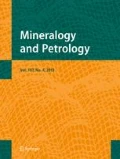Summary
¶We report, for the first time, the occurrence of five palladium-rich, one palladium bearing and two gold-silver minerals from podiform chromitites in the Eastern Alps. Minerals identified include braggite, keithconnite, stibiopalladinite, potarite, mertieite II, Pd-bearing Pt-Fe alloy, native gold and Ag-Au alloy. They occur in heavy mineral concentrates produced from two massive podiform chromitite samples (unaltered and highly altered) of the Kraubath ultramafic massif, Styria, Austria. Distribution patterns of platinum-group elements (PGE) in these chromitites show considerable differences in the behaviour of the less refractory PGE (PPGE-group: Rh, Pt, Pd) compared to the refractory PGE (IPGE-group: Os, Ir, Ru). PPGE are more enriched in chromitite showing pronounced alteration features. The unaltered chromitite displays a negatively sloped chondrite-normalised PGE pattern similar to typical ophiolitic-podiform chromitite.
Except for the Pd- and Au-Ag minerals that are generally rare in ophiolites, about 20 other platinum-group minerals (PGM) have been discovered. They include PGE-sulphides (laurite, erlichmanite, kashinite, bowieite, cuproiridsite, cuprorhodsite, unnamed Ir-rich variety of ferrorhodsite, unnamed Ni-Fe-Cu-Rh- and Ni-Fe-Cu-Ir-Rh monosulphides), PGE alloys (Pt-Fe, Ir-Os, Os-Ir and Ru-Os-Ir), PGE-sulpharsenides (irarsite, hollingworthite, platarsite, ruarsite and a number of intermediate species), sperrylite and a Ru-rich oxide (?). Three PGM assemblages have been recognised and attributed to different processes ranging from magmatic to hydrothermal and weathering-related.
Pd-rich minerals are characteristic of both chromitite types, although their chemistry and relative proportions vary considerably. Keithconnite, braggite and Pd-bearing ferroan platinum, together with a number of PGE-sulphides (mainly laurite-erlichmanite) and alloys, are typical only of the unaltered podiform chromitite (assemblage I). Euhedral mono- and polyphase PGM grains in the submicron to 100 µm range show features of primary magmatic assemblages. The diversity of PGM in these assemblages is unusual for ophiolitic environments. In assemblage II, laurite-erlichmanite is intergrown with and overgrown by PGE-sulpharsenides; other minerals of assemblage I are missing. Potarite, stibiopalladinite, mertieite II, native gold and Ag-Au alloys, as well as PGE-sulpharsenides, sperrylite and base metal arsenides and sulphides are characteristic for the highly altered chromitite (assemblage III). They occur either interstitial to chromite in association with metamorphic silicates, in chromite rims or along cracks, and are thus interpreted as having formed by remobilization of PGE by hydrothermal processes during polyphase regional metamorphism.
Similar content being viewed by others
Author information
Authors and Affiliations
Additional information
Received August 3, 2000;/revised version accepted December 28, 2000
Rights and permissions
About this article
Cite this article
Malitch, K., Melcher, F. & Mühlhans, H. Palladium and gold mineralization in podiform chromitite at Kraubath, Austria. Mineralogy and Petrology 73, 247–277 (2001). https://doi.org/10.1007/s007100170002
Issue Date:
DOI: https://doi.org/10.1007/s007100170002



